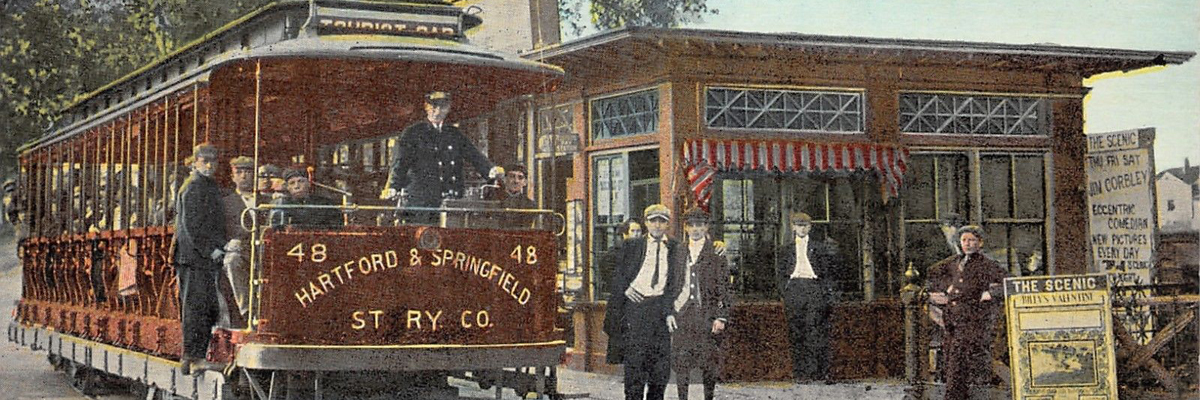
The trolley ride that visitors enjoy during their visit to the trolley museum follows the path of the Hartford & Springfield Street Railway's Rockville Branch. The following is a brief history of the railway and the trolley park that was located not far from the museum.
The Hartford & Springfield Street Railway was a high-speed interurban electric railway system running between the namesake cities that started operation in 1901 with the merger of a few smaller street railway companies. The system was made up of some forty miles of track, connecting the local street railway systems of Hartford and Springfield with branches extending from Thompsonville to Somers and Warehouse Point to Rockville (built in 1902 and 1906 respectively).
The main line on the east side of the Connecticut River was completed in 1902 and began with the connection of the Hartford Street Railway Company at East Windsor Hill and ran north along the east side of the river through Warehouse Point, Enfield, Thompsonville to the Massachusetts State line where it connected to the Springfield Street Railway.
The main line on the west side was initially planned in 1897, however it wasn't until 1904 when it was completed. The route began at the connection with the Hartford Street Railway system in the town of Windsor, extending along the west bank of the river through Haydens, Windsor Locks, and Suffield to the connection with the Springfield Street Railway.
The Hartford & Springfield was a very important piece of the electric railway system in New England. It was not only the link between the upper and lower Connecticut Valley, but it was also the only link between the entire street railway network of southern and northern New England. This connection allowed travelers to travel between New York and Boston by trolley.
Trolley service was discontinued in 1926 as the company went into foreclosure due to mounting debt. All assets were transferred over to the Hartford & Springfield Coach Company.

Hartford & Springfield Street Railway's Thompsonville waiting station in Enfield, Connecticut
As the trolley lines converted from horse-drawn vehicles to the more far-reaching electrified streetcars, not only could people find it moderately more convenient to live further away from the population centers. Unfortunately, with this larger network of routes, trolleys needed to run seven days a week since they were considered a public service, but almost all of the revenues came from the work week, Monday through Saturday.
To encourage more people riding trolleys on Sundays, small park-like destinations were constructed by the trolley companies to provide the public opportunities to picnic and be social. These special destinations became known as "trolley parks".
Having the Warehouse Point area of Connecticut strategically about equidistant to the big cities of Hartford and Springfield, it seemed to be a natural location for a trolley park. Warehouse Point at that time was mostly a farming community with its inherent farming related aromas, which were deemed by some as being pure country air - "good for the lungs and what ails ya".
In a small area just outside of Warehouse Point proper and slightly west of, but including, the Scantic river gorge, there came into being Piney Ridge Park.
Set in a heady grove of pine forest, a picnic area was set up which very quickly evolved to include a dance pavilion, a ball field, a carousel, and many more recreational amenities. Families now had an after-church fun destination to look forward to, fleeing some of those very hot, Tobacco Valley summers aboard the ever popular, naturally air-conditioned open trolleys.
The short heyday for most of these trolley parks was arguably the 1910-1920's. As the public became more sophisticated and the automobile flashed upon the scene, with subsequent decreasing attendance it became uneconomical for the trolley company owners and shareholders to maintain the smaller facilities. However, a few of the larger and more elaborate destination parks such as Quasey in Middlefield and Lake Compounce in Bristol did continue on and still survive to this day.

Trolleys were an important part of life in Connecticut from the late 1800s through the mid-20th century. In an age before family ownership of an automobile was common, the trolley gave the average person an affordable, convenient way to travel around town and between towns, creating many suburban communities. The map below shows the extant of the trolley lines across the state at the height of the trolley era.
